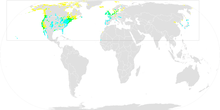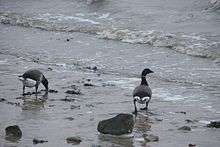Brant (goose)
| Brant | |
|---|---|
 | |
| Scientific classification | |
| Kingdom: | Animalia |
| Phylum: | Chordata |
| Class: | Aves |
| Order: | Anseriformes |
| Family: | Anatidae |
| Genus: | Branta |
| Species: | B. bernicla |
| Binomial name | |
| Branta bernicla (Linnaeus, 1758) | |
 | |
| Global range Year-Round Range Summer Range Winter Range | |
The brant, also known as the brent goose (Branta bernicla) is a species of goose of the genus Branta. The black brant is an American subspecies.
The Brent System, a major oilfield, was named after the species.[2]
Description

The brant is a small goose with a short, stubby bill. It measures 55–66 cm (22–26 in) long, 106–121 cm (42–48 in) across the wings and weighs 0.88–2.2 kg (1.9–4.9 lb).[3][4][5] The under-tail is pure white, and the tail black and very short (the shortest of any goose).
The species is divided three subspecies:
- Dark-bellied brant B. b. bernicla (Linnaeus, 1758)
- Pale-bellied brant B. b. hrota (Müller, 1776) (sometimes also known as light-bellied brent goose in Europe, and Atlantic brant in North America)
- Black brant B. b. nigricans (Lawrence, 1846) (sometimes also known as the Pacific brant in North America)
Some DNA evidence suggests that these forms are genetically distinct; while a split into three separate species has been proposed, it is not widely accepted, with other evidence upholding their maintenance as a single species.
The body of the dark-bellied form is fairly uniformly dark grey-brown all over, the flanks and belly not significantly paler than the back. The head and neck are black, with a small white patch on either side of the neck. It breeds on the Arctic coasts of central and western Siberia and winters in western Europe, with over half the population in southern England, the rest between northern Germany and northern France.
The pale-bellied brant appears blackish-brown and light grey in colour. The body is different shades of grey-brown all over, the flanks and belly are significantly paler than the back and present a marked contrast. The head and neck are black, with a small white patch on either side of the neck. It breeds in Franz Josef Land, Svalbard, Greenland and northeastern Canada, wintering in Denmark, northeast England, Ireland and the Atlantic coast of the U.S. from Maine to Georgia.
The black brant appears blackish-brown and white in colour. This form is a very contrastingly black and white bird, with a uniformly dark sooty-brown back, similarly-coloured underparts (with the dark colour extending furthest back of the three forms) and a prominent white flank patch; it also has larger white neck patches, forming a near-complete collar. It breeds in northwestern Canada, Alaska and eastern Siberia, and wintering mostly on the west coast of North America from southern Alaska to California, but also some in east Asia, mainly Japan.
The Asian populations of the black brant populations had previous been regarded as a separate subspecies orientalis based on purported paler upperparts coloration; however, it is generally now believed that this is not correct.
A fourth form (known variously as gray brant, intermediate brant, or grey-bellied brent goose) has been proposed, although no formal subspecies description has been made as yet, for a population of birds breeding in central Arctic Canada (mainly Melville Island), and wintering on Puget Sound on the American west coast around the U.S./Canada border. These birds are intermediate in appearance between black brant and pale-bellied brant, having brown upperparts and grey underparts which give less of a contrast with the white flank patch. Given that this population exhibits mixed characters, it has also been proposed that, rather than being a separate subspecies, it is actually a result of interbreeding between these two forms.
Habitat

It used to be a strictly coastal bird in winter, seldom leaving tidal estuaries, where it feeds on eel-grass (Zostera marina) and the seaweed, sea lettuce (Ulva). On the east coast of North America, the inclusion of sea lettuce is a recent change to their diet, brought about by a blight on eelgrass in 1931. This resulted in the near-extirpation of the brant. The few that survived changed their diet to include sea lettuce until the eelgrass eventually began to return. Brants have maintained this diet ever since as a survival strategy.[6] In recent decades, it has started using agricultural land a short distance inland, feeding extensively on grass and winter-sown cereals. This may be behavior learned by following other species of geese. Food resource pressure may also be important in forcing this change, as the world population has risen over 10-fold to 400,000-500,000 by the mid-1980s, possibly reaching the carrying capacity of the estuaries. In the breeding season, it uses low-lying wet coastal tundra for both breeding and feeding. The nest is bowl-shaped, lined with grass and down, in an elevated location, often in a small pond.
The brant goose is one of the species to which the Agreement on the Conservation of African-Eurasian Migratory Waterbirds applies.
Etymology
Branta is a Latinised form of Old Norse brandgás, "burnt (black) goose) and bernicla is the medieval Latin name for the barnacle. The brant and the similar barnacle goose were previously considered one species, formerly believed to be the same creature as the crustacean.[7] That myth can be dated back to at least the 12th century. Gerald of Wales claimed to have seen these birds hanging down from pieces of timber, William Turner accepted the theory, and John Gerard claimed to have seen the birds emerging from their shells. The legend persisted until the end of the 18th century. In County Kerry, until relatively recently, Catholics could eat this bird on a Friday because it counted as fish.[8]
References
- ↑ BirdLife International (2012). "Branta bernicla". IUCN Red List of Threatened Species. Version 2013.2. International Union for Conservation of Nature. Retrieved November 26, 2013.
- ↑ "UK Brent Oil". One Financial Markets. Retrieved 25 August 2014.
- ↑ "Brant". All About Birds. Cornell Lab of Ornithology. Retrieved 18 October 2011.
- ↑ "Brent Goose". Oiseaux-birds.com. Retrieved 18 October 2011.
- ↑ Dunning, John B. Jr., ed. (1992). CRC Handbook of Avian Body Masses. CRC Press. ISBN 978-0-8493-4258-5.
- ↑ Book of North American Birds. 1990.
- ↑ Jobling, James A (2010). The Helm Dictionary of Scientific Bird Names. London: Christopher Helm. pp. 70, 77. ISBN 978-1-4081-2501-4.
- ↑ Cocker, Mark; Mabey, Richard (2005). Birds Britannica. London: Chatto & Windus. pp. 78–80. ISBN 0-7011-6907-9.
Further reading
- Shields, Gerald F. (July 1990). "Analysis of mitochondrial DNA of Pacific Black Brant". The Auk. American Ornithologists' Union. 107 (3): 620–623.
- Syroechkovski, E.E.; Zöckler, C.; Lappo, E. (December 1998). "Status of Brent Goose in northwestern Yakutia, East Siberia" (PDF). British Birds. British Birds Rarities Committee. 91 (12): 565–572.
- Ebels, E.B. (1997). "Identification of brent geese: a new feature" (PDF). Dutch Birding. Dutch Birding Association. 19 (5): 232–236 (highlights the difference in belly colour between the various forms).
External links
| Wikimedia Commons has media related to Branta bernicla. |
| Wikispecies has information related to: Branta bernicla |
- BirdGuides Brent Goose Page
- Brent Goose at RSPB: Birds by Name
- BBC Nature - Brent Goose
- Stamps from Canada, Germany, Germany-west, and Jersey at bird-stamps.org
- "Brent Goose media". Internet Bird Collection.
- Brant photo gallery at VIREO (Drexel University)
- Brant Goose, B.C. Outdoor Wilderness Guide
- Interactive range map of Branta bernicla at IUCN Red List maps
